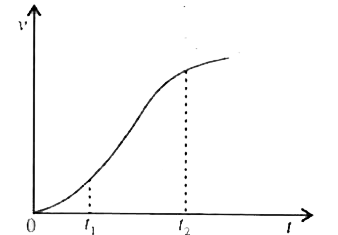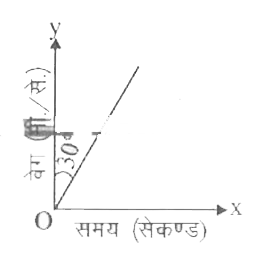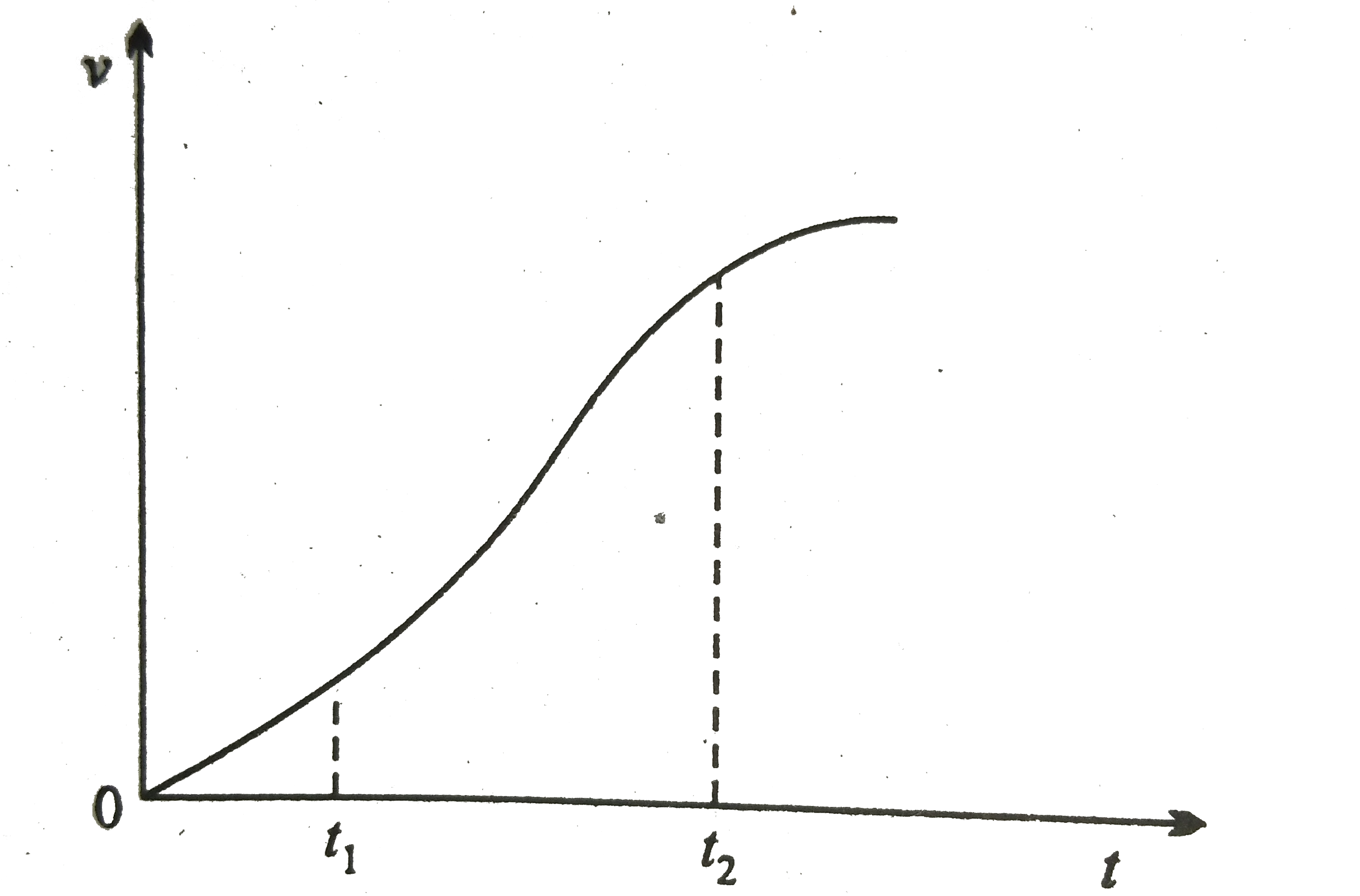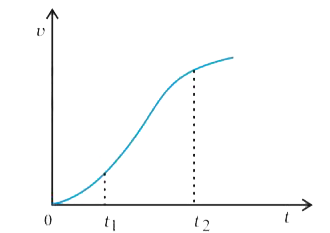एकविमीय गति में किसी कण का वेग - समय ग्राफ चित्र में दिखाया गया है-

दिए सूत्रों में t1 से t2 तक के समय अंतराल की अवधि में कण की गति का वर्णन करने के लिए कौन - से सूत्र सही हैं
(i) x(t2)=x(t1)+v(t1)(t2−t1)+(1/2)a(t2−t1)2
(i8i) v(t2)=v(t1)+a(t2−t1)
(iii) vaverage=[x(t2)−x(t1)]/(t2−t1)
(iv) aaverage=[v(t2)−v(t1)]/(t2−t1)
(v) x(t2)=x(t1)+vaverage(t2−t1)+(1/2)aaverage(t2−t1)2
(vi) x(t2)−x(t1)=t− अक्ष तथा दिखाई गई बिंदुकित रेखा के बीच दर्शाए गए वक्र के अंतर्गत आने वाला क्षेत्रफल |
ग्राफ से स्पष्ट है कि वक्र का ढलान स्थिर तथा एकसमान नहीं है| अतः संबंध (i ), (ii ) तथा (v ) सही नहीं हैं, लेकिन संबंध (iii ), (iv ) तथा सही हैं|
Topper's Solved these Questions
- BOOK - SANJEEV PUBLICATIONCHAPTER - सरल रेखा में गति EXERCISE - अन्य महत्वपूर्ण प्रश्न (बहुचयनात्मक प्रश्न-)16videos
सरल रेखा में गति
- BOOK - SANJEEV PUBLICATIONCHAPTER - सरल रेखा में गति EXERCISE - अन्य महत्वपूर्ण प्रश्न (रिक्त स्थानों को की पूर्ति कीजिए-)10videos
सरल रेखा में गति
- BOOK - SANJEEV PUBLICATIONCHAPTER - सरल रेखा में गति EXERCISE - अभ्यास (पाठ्यपुस्तक के प्रश्न)22videos
सरल रेखा में गति
- BOOK - SANJEEV PUBLICATIONCHAPTER - समतल रेखा में गतिEXERCISE - गत वर्षों की विभिन्न प्रतियोगी परीक्षाओं में पूछे गये प्रश्न26videos
समतल रेखा में गति
Similar Questions
एक कण की एकविमीय गति के लिए वेग - समय ग्राफ चित्र के अनुसार है | कण का त्वरण है | (मी./से2 में )-
 12:25View Solution
12:25View Solutionदो कारों का समय - विस्थापन ग्राफ दो समान्तर रेखाओं से प्रदर्शित होता है | उनके वेगों में ..................................का सम्बन्ध होता है |
05:58View Solutionनीचे दिए गए गति के कौन-से उदाहरणों में वस्तु को लगभग बिंदु वस्तु माना जा सकता है -
दो स्टेशनों के बीच बिना किसी झटके के चल रही कोई रेलगाड़ी |
(b) किसी वृत्तीय पथ पर साईकिल चला रहे किसी व्यक्ति के ऊपर बैठा कोई बन्दर |
(c) जमीन से टकरा कर तेजी से मुड़ने वाली क्रिकेट की कोई फिरकती गेंद |
(d) किसी मेज के किनारे से फिसल कर गिरा कोई बीकर |03:15View Solutionक्षैतिज घर्षण विहीन टेबिल के केंद्र पर स्थित खूंटी से l लंबाई की डोरी का एक सिरा बांधा गया है तथा दूसरे सिरे पर m द्रव्यमान का एक कण बांधा उसे v वेग से वृत्तीय गति करवाई जाती है कण पर केंद्र की ओर लगने वाला बल होगा (T डोरी में तनाव को दर्शाता है)
05:36View SolutionIf the normals at points t1andt2 meet on the parabola, then t1t2=1 (b) t2=−t1−2t1 t1t2=2 (d) none of these
05:03View SolutionThe velocity-time graph of a particle in one-dimensional motion is shown in Fig.:

(a) Which of the following formulae are correct for describing the motion of the particle over the time-interval t1 to t2:
(a) x(t2)=x(t1)+v(t1)(t2−t1)+(1/2)a(t2−t1)2
(b) v(t2)=v(t1)+a(t2−t1)
(c) vaverage=(x(t2)−x(t1))/(t2−t1)
(d) aaverage=(v(t2)−v(t1))/(t2−t1)
(e) x(t2)=x(t1)+vaverage(t2−t1)+(1/2)aaverage(t2−t1)2
(f) x(t2)−x(t1) = area under the v−t curve bounded by the t-axis and the dotted line shown.03:32View SolutionFor any arbitrary motion in space, which of the following relations are true?
(a) vaverage=(1/2)(v(t1)+v(t2))
(b) vaverage=[r(t2)−r(t1]/(t2−t1)
(c) v(t)=v(0)+at
(d) aaverage=[v(t2)−v(t1)]/(t2−t1)
The average stands for average of the quantity over time interval t1 to t203:25View Solutionएकविमीय गति में किसी कण का वेग-समय ग्राफ चित्र 3.29 में दिखाया गया है :

नीचे दिए सूत्रों में t1 से t2 तक के समय अंतराल की अवधि में कण की गति का वर्णन करने के लिए कौन-सा सूत्र सही है :
(i) x(t2)=x(t1)+v(t1)(t2−t1)+(1/2)a(t2−t1)2
(ii) v(t2)=v(t1)+a(t2−t1)
(iii) vaverage=[x(t2)−x(t1)]/(t2−t1)
(iv) aaverage=[v(t2)−v(t1)]/(t2−t1)
(v) x(t2)=x(t1)+vaverage(t2−t1)+(1/2)aaverage(t2−t1)2
(vi) x(t2)−x(t1)=t-अक्ष तथा दिखाई गई बिंदुकित रेखा के बीच दर्शाए गए वक्र के अंतर्गत आने वाला क्षेत्रफल |View Solutionएकविमीय गति में किसी कण का वेग-समय ग्राफ चित्र में दिखाया गया है -

नीचे दिये सूत्रों में t1 से t2 तक के समय अंतराल की अवधि में कण की गति का वर्णन करने के लिए कौन-से सूत्र सही हैं -
(i) x(t2)=x(t1)+v(t1)(t2−t1)+(1/2)a(t2−t1)2
(ii) v(t2)=v(t1)+a(t2−t1)
(iii) vaverage=[x(t2)−x(t1)]/(t2−t1)
(iv) vaverage=[v(t2)−v(t1)]/(t2−t1)
(v) x(t2)=x(t1)+vaverage(t2−t1)+(1/2)aaverage(t2−t1)2
(vi) x(t2)−x(t1)=t− अक्ष तथा दिखाई गाड़ी बिंदुकित रेखा के बीच दर्शाए गए वक्र के अंतर्गत आने वाला क्षेत्रफल ।View SolutionThe velocity-time graph of a particle in one-dimensional motion is shown in Fig.

Which of the following formulae are correct for describing the motion of the particle over the time-interval t1 to t2 :
(a) x(t2)=x(t1)+υ(t1)(t2−t1)+(1/2)a(t2−t1)2
(b) υ(t2)=υ(t1)+a(t2−t1)
(c ) υaverage=(x(t2)−x(t1))/(t2−t1)
(d) aaverage=(υ(t2)−υ(t1))/(t2−t1)
(e ) x(t2)=x(t1)+υaverage(t2−t1)+(1/2)aaverage(t2−t1)2
(f) x(t2)−x(t1)= area under the υ−t curve bounded by the t-axis and the dotted line shown.View SolutionProve that the point of intersection of the tangents at t1andt2 on the parabola y2=4ax is (at1t2,a(t1+t2))
04:22View SolutionFor any arbitrary motion in space , which of the following relations are true : (a) Vaverage=(1/2)(v(t1)+v(t2))
(b) Vaverage=[r(t2)−r(t1)]/(t2−t1)
(c ) V(t)=V(0)+at
(d) r(t)=r(0)+v(0)T+(1/2)at2
(e ) aaverage=[v(t2)−v(t1)]/(t2−t1)
(The average stands for average of the quantity over the time interval t1 to t2)03:29View SolutionFor any arbitrary motion in space , which of the following relations are true : (a) V_("average")=(1//2)(v(t_(1))+v(t_(2))) (b) V_("average")=[r(t_(2))-r(t_(1))]//(t_(2)-t_(1)) (c ) V(t)=V(0)+at (d) r(t) =r(0)+v(0)T+(1//2)at^(2) (e ) a_("average")=[v(t_(2))-v(t_(1))]//(t_(2)-t_(1)) (The average stands for average of the quantity over the time interval t_(1)" to "t_(2))
View SolutionFor any arbitrary motion in space , which of the following relations are true : (a) Vaverage=(1/2)(v(t1)+v(t2))
(b) Vaverage=[r(t2)−r(t1)]/(t2−t1)
(c ) V(t)=V(0)+at
(d) r(t)=r(0)+v(0)T+(1/2)at2
(e ) aaverage=[v(t2)−v(t1)]/(t2−t1)
(The average stands for average of the quantity over the time interval t1 to t2)02:40View SolutionFor any arbitrary motion in space , which of the following relations are true : (a) Vaverage=(1/2)(v(t1)+v(t2))
(b) Vaverage=[r(t2)−r(t1)]/(t2−t1)
(c ) V(t)=V(0)+at
(d) r(t)=r(0)+v(0)T+(1/2)at2
(e ) aaverage=[v(t2)−v(t1)]/(t2−t1)
(The average stands for average of the quantity over the time interval t1 to t2)06:44View Solution

